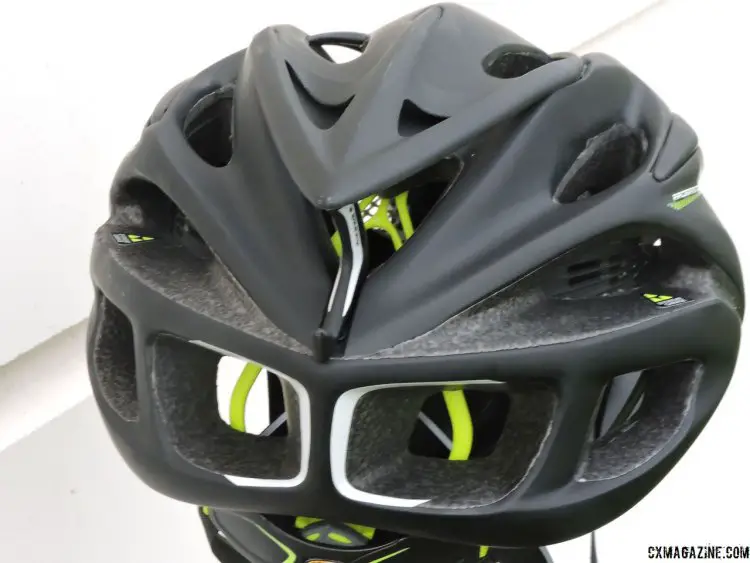The importance of proper head protection is back in the news after Richie Porte and Dan Martin's scary crashes over the weekend at the Tour de France. Martin's team took to social media to show the importance of a properly fitting helmet when racing at high speeds:
https://twitter.com/quickstepteam/status/884071157682581505
Many helmet manufacturers use their research and development teams to push the envelope in helmet safety and the Rudy Project is no different. Rudy Project's newest proprietary safety technology is the HexoCrush liner, which uses a hexagonal design to direct impact forces away from the head.
I recently had the opportunity to review Rudy Project's newest helmet, the Racemaster, to see how it stacks up as a ’cross compatible piece of headwear.

The Rudy Project Racemaster comes in several colors - shown here in matte black - weighs 310g and retails for $350. It comes with a removable liner, carrying bag and a rear eyewear garage for sunglasses storage. © Cyclocross Magazine
The Next Step for the Rudy Project
Originally founded in Italy, the Rudy Project produced its first helmet, the CX, in 1993 and their first aero helmet in 1996. The Rudy Project's helmets have evolved since its initial offering, and prior to the introduction of the Racemaster, the company's two flagship road helmets were the Sterling (reviewed by Cyclocross Magazine here)and the carbon-fiber Windmax According to a Rudy Project spokesman, the Racemaster was designed to combine the comfort of the Sterling with the lightness of the Windmax.

The Rudy Project produced its first helmet, the CX, in 1993 © The Rudy Project
The Racemaster includes a new safety feature called the HexoCrush liner developed to provide better protection during impact. The Rudy Project's website describes its new technology at this page on its website.
With the HexoCrush liner, Rudy Project joins companies such as Kali that are using research to develop safer protection technologies. The Racemaster also provides an option equipped with the MIPS (Multi-Directional Impact Protection System) technology.
Rudy Project's sunglasses have become a mainstay on the world tour, and this year, the Racemaster has made its way to the tour as well. A gold version of the Racemaster can be seen on members of the Bahrain-Merida team, which includes 2014 Tour de France champion Vincenzo Nibali.

Rudy Project's helmets have evolved into the Racemaster since the CX was first released. © Cyclocross Magazine
A Bagful of Features on the Racemaster
When Cyclocross Magazine reviewed the Sterling, we were impressed by the extra features provided with the helmet. The Racemaster is no less impressive in the extras it provides to accompany Rudy Project's proprietary safety liner.
Keeping the insides of helmets clean and odor-free during the summer riding months is a challenge all riders are familiar with. The Racemaster addresses this with a removable cloth liner that can be removed and placed in the wash. A spare liner is also provided to limit headaches when the other is in the wash.

The Racemaster comes with two removeable liners for sweat and odor management. The liner took some getting used to, but it our tester found it does not make the helmet excessively hot during warm weather. © Cyclocross Magazine
Sunglasses storage has traditionally been another challenge riders have had to deal with. The Racemaster provides a solution to this problem by providing an "Eyewear Garage" on the rear of the helmet. (Bollé’s The One is another helmet with a dedicated location for sunglasses storage Cyclocross Magazine has reviewed.)
According to Rudy Project, it was specifically designed to prevent discomfort and damage to a rider's eyewear by keeping the arms of the glasses from making contact with the rider's head. I observed the Eyewear Garage integrates well into the design of the helmet, and when I used it to store my glasses, it kept the arms secured away from my head.

The Rudy Project Racemaster helmet features a rear eyewear garage for sunglasses storage. © Cyclocross Magazine
The third accessory I liked was the cloth carrying bag that comes with the Racemaster. It can be easy for helmets to get scuffed up when transporting them to races, so the tote bag provides an effective way of keeping the helmet looking good and avoid damage from tossing it around in the back seat.
Rudy Project Racemaster Review
The Racemaster comes in four colors - matte black, matte white and gold. Perhaps not feeling bold enough to go for the gold, I opted for the matte black option. The helmet comes in two sizes - small (54/58cm) and large (59/61cm) - and I went with the large.
With all bike equipment, weight is an issue riders are concerned about. The Racemaster's weight is listed as 310 grams with accessories, and I recorded a weight of 334 grams. For reference, Issue 30 went in search of the perfect 'cross helmet and found weights ranging from 246g to 327g, with an average of 290g, for six reviewed helmets.
Balancing safety with adequate ventilation is a challenge for helmet manufacturers. The Racemaster has 10 long vents along the top of the helmet and another six on the back. I have been wearing the Racemaster for about a month now and although the feeling of a liner inside the helmet may take some getting used to, I have not had any issues with poor ventilation.
One aspect of the Racemaster that impressed me was the quality of the fit. The first thing I noticed when I put the Racemaster on was how comfortable it is. The padded, removable liner fit nicely against my head and provided a level of comfort I have not experienced with helmets that have small pads between the vents.
Helmets with coarse adjustment settings can be difficult to get to the right setting, but the micro-dialed rear adjustment dial made it easy to obtain a snug fit. The side straps were also easily adjustable, even when wearing the helmet, and the broad, flat buckles fit flush against my cheeks.

The rear adjustment dial features micro settings that allow for our tester to obtain a snug fit for off-road riding. © Cyclocross Magazine
Although I have been slow to upgrade my helmets in the past (see photo), I have learned the hard way it is important to find one with a good fit.

The reviewer has learned the hard way a properly-fitting helmet is important. photo: Andrew Aaron.
My head is more of a long and narrow shape, and I found the Racemaster will probably fit someone with a round head best. The Racemaster also seemed to sit up on my head a bit higher than the Gyro I currently use (my current helmet fits better than the one in the photo, I swear).
I was a little bummed I did not have the opportunity to test out the Racemaster during the ’cross season, but I have been able to test its off-road capabilities at a few Wisconsin Off-Road Series mountain bike races.
After nearly two hours of ripping some muddy singletrack at Iola that had me dreaming of cyclocross season, I was very happy with the Racemaster’s off-road performance. The adjustment settings allowed me to get the helmet comfortably dialed in, and to be honest, the fit was comfortable enough I kind of forgot I was taking it out for a test spin. This may also be due in part to the stress of riding some of the slick corners, but the helmet did nicely maintain its snug fit throughout the race.
Overall Helmet Impressions
At a list price of $350, the Rudy Project Racemaster is one of the higher-end helmets Cyclocross Magazine has reviewed, but with the advanced safety features the company has engineered and the other accessories it provides, riders are getting a lot for their investment. I liked the quality of the fit and the removable liners are a thoughtful addition to help manage odor and improve the durability of the helmet.

The straps on the Racemaster are easy to adjust and feature a large, flat buckle to help contribute to the snug fit I was able to obtain with the Racemaster. © Cyclocross Magazine
The list weight of the Racemaster is 310 grams, which is average compared to other helmets Cyclocross Magazine has reviewed. Riders looking to invest to save weight are likely to find lighter options on the market.
During my test rides, the Racemaster proved itself up to the rigors of off-road riding. The micro adjustment dial and easily adjustable straps allowed me to obtain a snug fit, and the helmet stayed secure while ripping around some local singletrack.
Rudy Project Racemaster Helmet
MSRP: $350 (MiPS Option: $400)
Weight: 310 grams (Large)
Sizes: Small (54/58cm) and Large (59/61cm)
Colors: Matte white, matte black, titanium red and gold
Vents: 16
Safety Features: HexoCrush proprietary liner; MiPS option available
Other Features: Eyewear Garage on rear of helmet, two removable liners
For more information: e-rudy.com




























